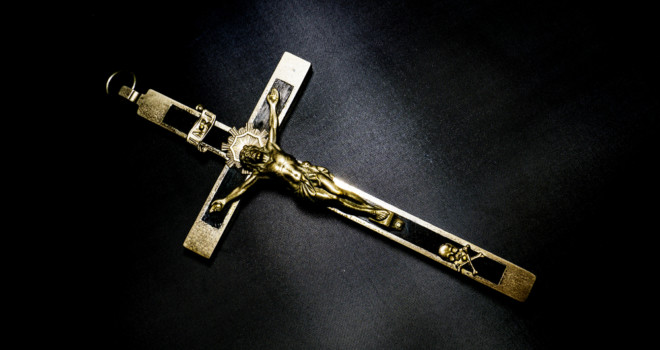Q: I have a very old crucifix which has a skull and crossbones at the bottom of the cross. What does that mean? Also, what does INRI mean? I have heard people pronounce it as though it were one word.
Both the INRI and the skull and crossbones are mentioned in the passion accounts of our Lord. First, INRI is an abbreviation for the Latin Iesus Nazarenus Rex Iudaeorum, meaning “Jesus the Nazorean, King of the Jews.” In sentencing our Lord to death, Pontius Pilate had this inscription written in Hebrew, Latin and Greek (Jn 19:20) placed on the Cross above the head of our Lord.
Each of the Gospels testifies to this inscription, although with slight variations: St. John’s Gospel, “Jesus the Nazorean, the King of the Jews”; St. Matthew’s Gospel, “This is Jesus, King of the Jews”; St. Mark’s Gospel, “The King of the Jews”; and St. Luke’s Gospel, “This is the King of the Jews.” Since St. John stood with the Blessed Mother at the foot of the Cross, his Gospel is the most accurate, although all of the Gospels agree in substance as to what was written.
Another interesting point arises in artwork depicting the Crucifixion. Sometimes the inscription will be fully spelled-out (not simply INRI), but spelled backward. The artists are mindful that Hebrew is read from right to left, not left to right as in English.
Finally, the use of all three languages — Hebrew, Latin and Greek — served a dual purpose. First, these were the languages that would have been spoken in Jerusalem at the time of the Crucifixion. Secondly, Hebrew was the language of the chosen people, the people of the Old Covenant; Latin and Greek were the languages of the Gentiles and Imperial Rome. Jesus came to save not just the Jew but also the Gentile, so the proclamation reminds us that the sacrifice is for all mankind. While the powers of this world labeled Him as an earthly king, Jesus, crucified and risen, is the King who conquered sin and death, and whose kingdom will not end.
Next, the skull and the crossbones has a dual significance. First, Jesus was crucified just outside the old city of Jerusalem at Golgotha, meaning “Skull Place” in Hebrew. The four Gospels all attest to this fact: Matthew 27:33, Mark 16:22, Luke 23:33, and John 19:17. The word “golgotha” is an Aramaic form of the Hebrew word “gulgoleth“, meaning “skull.” The Latin word “calva“, also meaning “skull,” is the root for “Calvary.”
Secondly, an ancient tradition relates that this spot was also where Adam was buried, hence the depiction of both the skull and crossbones. Today, at the Church of the Holy Sepulcher in Jerusalem, the Greek Orthodox have a chapel built over the rock of Calvary itself, and the place where the Cross was erected is marked by a silver disk right below the altar. To the right of the altar, there is a crack in the rock. The Gospel of St. Matthew states that when Christ died on the Cross, “the earth quaked, boulders split, tombs opened” (Mt 27:52). The crack continues down to the Chapel of Adam (in the Church of the Holy Sepulcher) where tradition holds Adam was buried and where the Precious Blood of our Lord dripped upon his bones and his skull. Here the blood of Christ flowing from the Sacred Heart of our Lord would have been a stream of redemption, touching all, even Adam himself.
Christ, the new Adam, obedient to the Heavenly Father’s will unto to death, conquered the sin committed when the first Adam disobeyed God. The gates of heaven closed by the sin of Adam were now opened by the sacrifice of our Lord.
These two symbols placed on the crucifix help us to remember that our Lord’s sacrifice on the Cross is the greatest act of love God has shown to us. Therefore, each time we gaze upon our crucified Lord we should be moved to say as did St. Francis of Assisi, “We adore You, O Christ, and we praise You, for by Your holy cross You have redeemed the world.”
(This article courtesy of the Arlington Catholic Herald.)












